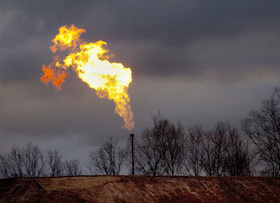Oil and gas operations produce a variety of air emissions such as hazardous air pollutants and greenhouse gases (e.g., methane and carbon dioxide).
Emissions of greenhouse gases and other pollutants can be reduced by using a number of cost effective technologies and practices. These include monitoring and pinpointing fugitive emissions, and then sealing the leaks; using lower heater treater temperatures; connecting storage tanks to flare systems; converting gas-driven chemical pumps to electric-, air- or nitrogen driven pumps; compressing casing gas and shutting down line pigging. Also, air emission may be decreased by installing: no-bleed or low-bleed pneumatic devices; vapor recovery units; high efficiency flares; closed-loop skimmers on water tanks; and separator pumps and evacuators on pipeline bleeders.[1]
If the control valves on a pump’s separator unit, which separates the methane and water, are replaced with better valves, methane emissions to the atmosphere can be reduced. This will have positive environmental benefits, as methane is a powerful greenhouse gas that contributes to global warming. By replacing 3,300 controllers on 2,760 wells in Colorado and New Mexico, the Colorado Oil and Gas Conservation Commission expects that methane emissions will be reduced by 12,000 tons per year in the San Juan Basin. According to an engineer with the company BP, replacing valves not only has a positive benefit with greenhouse gases, it also has a positive economic benefit for that company.[2]
Wellhead compressors that are powered by natural gas emit NOx and VOCs (which contribute to ground-level ozone) and carbon monoxide. According to the federal Bureau of Land Management, there are add-on technologies, such as catalytic converters, that can reduce these emissions by as much as 95%.[3]
Cavitation baffle systems (large storm sewer concrete pipe) can be used to reduce flare height and contain the majority of coal dust during coalbed methane cavitation operations. [4]
Barrett Resources Corporation has minimized odors, a common complaint from surface owners, from some of its natural gas production sites by using combustion units designed to destroy vapors released by condensate tanks and glycol dehydrators. These units also reduce emissions of methane (a greenhouse gas), and other hydrocarbons that can affect visibility.
Standard glycol dehydrators which are used to remove water from natural gas, typically vent water and hazardous gases directly into the atmosphere. Glycol dehydrators are a major source of benzene emissions within the oil and gas industry. Fatalities from human exposure to high concentrations of benzene have been documented since the early 1900s, and studies have shown correlations between workplace exposure to benzene and the onset of certain forms of leukemia. The issue of air emissions from glycol dehydrators has only been identified in the past couple of decades. Most of the glycol dehydration units are installed in rural environments; they are typically left unattended, and emissions are not regularly monitored.
Emissions from glycol dehydrators can be reduced by: optimization of operations; equipment modifications or replacement; and/or, addition of emission control equipment. Emission controls such as condensers, flare stacks, and incinerators for still column vent vapors have been installed by industry at some locations. Research by the U.S. EPA has indicated that operators of glycol dehydrators often maintain a circulation rate that is at least two times higher than is needed to remove enough water from the gas. Therefore, companies can reduce their glycol use by performing simple calculations to determine the minimum circulation rate needed. By doing so, they will lose less methane to the atmosphere; improve the dehydrator unit efficiency; and decrease fuel pump use. EPA has calculated that by doing so, the potential savings for a dehydrator unit can range from $260 to $26,280 per year.[5]
For More Information
- Environmental Protection Agency. Natural Gas STAR Recommended Technologies and Practices.
- U.S. Forest Service. (2011) Emission Reduction Techniques for Oil and Gas Activities.
- Reducing benzene emissions from glycol dehydration: Working Group on Benzene Emissions from Glycol Dehydrators. (1997). Best Management Practices for the Control of Benzene Emissions from Glycol Dehydrators.
- Canadian Association of Petroleum Producers. Control of Benzene Emissions from Glycol Dehydrators. (2006)
Sources:
[2] Trujillo, Shirena. August 27, 2000. “In search of quieter, gentler wells.” Durango Herald.
[3] Bureau of Land Management. September, 2003. Draft Environmental Impact Statement – Surface Management of Gas Leasing and Development in the Carson National Forest, Jicarilla District. Chapter 3 – Air Quality. p. 3-75.
[4] Colorado Department of Natural Resources, Oil and Gas Conservation Commission. August 10, 2001. 2000 Outstanding Oil And Gas Operations Awards.
[5] Environmental Protection Agency (U.S. EPA). October, 2000. Profile of the Oil and Gas Extraction Industry. EPA Office of Compliance Sector Notebook Project. EPA/310-R-99-006. pp. 75-76.



